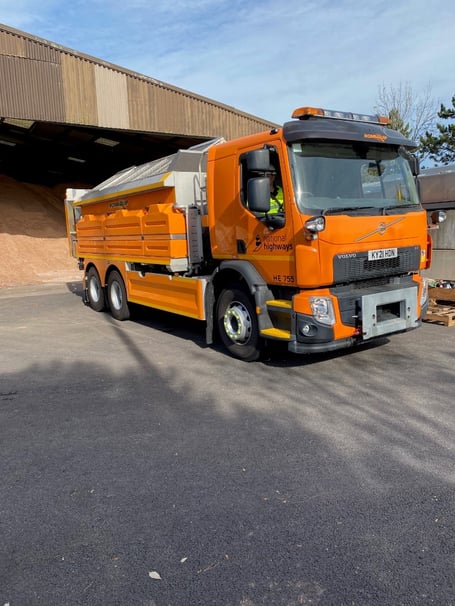With snow forecast this week, motorists are once again being reminded to give gritting vehicles time and space while they are out on National Highways’ roads network.
The message comes with more cold weather and snow forecast this week by the Met Office, and where conditions determine gritting vehicles need to go out, they will spread salt where needed.
Today, the Met Office has reported heavy rain which will change to overcast by the early evening. Tomorrow will be cloudy with a forecast of light snow by early the evening with lows of 3° degrees around midday which will slowly decrease to around 1° at around 9 pm.
A yellow weather warning of snow has been declared for Wednesday (08 March) where a period of snow is likely to cause some travel disruption. Thursday will see light showers.
The reminder follows the recent Know the Zones campaign launched by National Highways to help road users understand the blind spots HGV drivers face from passing and overtaking vehicles.
In a recent survey commissioned by National Highways, while nearly three-quarters of people said they take extra care when overtaking an HGV, 36 per cent said they did not know how many blind spots an HGV had. Thirty-six per cent also admitted feeling nervous when passing trucks.
National Highways manages 4,500 miles of A-roads and motorways and can call upon around 530 gritters in extreme weather conditions.
Darren Clark, Severe Weather Resilience Manager at National Highways, said: “As our gritting teams go out to spread salt on the roads, our message is simple to all road users: ‘Please be patient and give us the time and space to do what we need to do to keep you safe.
“If you are going to pass us, please do so courteously, pass us safely and legally, or even better, if you are able to stay back, you will actually help the salt on the road activate even more quickly by crushing and breaking it into the road surface which benefits everyone.
“It’s worth remembering too, we are not gritting all the time. Some of our fleets may come off at particular junctions or return to depots while other vehicles take over, lowering any inconvenience to motorists. We are once again totally committed to working around the clock on these seasonal operations to keep all road users safe and thank everyone in advance for their patience and understanding.”
Gritters have been going out whenever needed during the winter season and our teams across the country have been monitoring the Met Office weather forecasts along with regular road weather forecasts from meteorological experts MetDesk since then to determine when they need to go out to spread salt.
Darren Clark said: “Not all roads will need treating on any given day. Gritters may need to go out in some regions if road temperatures are expected to fall below +1 degrees C, and if there is a risk of ice forming, but not in other areas if conditions are not as cold.
“National Highways is committed to treating every road which needs to be treated - whenever it is needed. We are armed with the latest technology, forecasting intelligence and years of experience to help us make informed decisions about where and when we need to spread salt to help keep road users safe in even the most adverse weather conditions.”
RAC Breakdown spokesperson Rod Dennis said: “With a sudden switch to considerably colder conditions, the potential for vehicle breakdowns increases significantly. If a car struggles to start, the battery either needs charging – by taking it for at least a 30-minute drive – or is a sign it’s about to fail and will need replacing. It’s vital tyres have plenty of treads as a good grip is essential in cold conditions. Any tyres that are well-worn and approaching the legal tread limit should be changed as a matter of urgency. Drivers should also ensure their tyres are free of damage and are inflated to the correct pressures. We also strongly recommend drivers check their car’s oil and coolant levels and top up if necessary.”
National Highways recently completed the assembly of its new £44m two-year investment in a fleet of 252 Romaquip / Volvo gritter vehicles, some of which carried out winter operations last year, and all of which are involved in salt spreading this season. The investment now means the organisation has around 530 gritter vehicles available this winter. A total of 443 of these vehicles are Romaquip / Volvo gritters.
Vehicles in our winter gritting fleet can carry up to around 12,000 kg of salt, or 8,400 kg of salt and 3,600 litres of brine at any one time. The Romaquip / Volvo gritting vehicles can spread up to 50mph, encouraging traffic to keep moving more effectively on the roads even when they are being treated. When not treated they can travel up to 56mph.
Ready for the winter season
Winter can bring more adverse and severe weather conditions which can affect motorists and these include fog, heavy rain, high winds and gales and ice and snow.
Along with more than 250 weather stations, that provide us with real-time information about localised road conditions, National Highways works with independent meteorological experts Metdesk which runs from October 1 to April 30 and complements the national Met Office weather forecast, providing a level of granularity and precision about changing road surface temperatures across our road network. This gives us detailed knowledge to determine where and when to salt roads so they remain open and safe for people to use.
All of the information we gather helps us to inform road users about current road conditions whatever the weather. We also share information through channels including our website, third-party travel providers including sat nav companies and local radio stations.
Abigail Oakes, Senior Account Manager at the Met Office, said: “We are delighted to continue our close working relationship with National Highways this autumn and winter season.
“Our staff, be that meteorologists embedded alongside the National Highways team in Birmingham during the autumn and winter, or Met Office staff working from Exeter to deliver and support throughout the year, are proud to continue this partnership, which allows for the best possible support for road users during periods of severe weather.”
We have invested £44m over two years replacing 252 gritters. National Highways now has around 530 gritting vehicles which can be out on our roads in sub-zero temperatures helping us to maintain our network and enhance our service to customers. This equates to one gritter for every eight miles of road. The 530 gritters include 443 Romaquip Volvo gritting vehicles – all of which have been introduced through the replacement programme that started in 2018.
Explore more online:
National Highways has lots of advice on its website about travelling in severe weather conditions, including high winds and gales, fog, rain and snow and ice. Visit our travelling in severe weather web page.
Weather forecasts and information can be found on the Met Office website here.
Travel information can be found by visiting National Highways’ Travel updates page, and by following @highwaysnwest @highwaysneast @highwaysseast @highwaysswest @highwayseast @highwayswmids, @highwaysemids @highwaysyorks on Twitter or calling the National Highways Information Line on 0300 123 500





Comments
This article has no comments yet. Be the first to leave a comment.